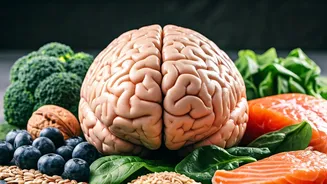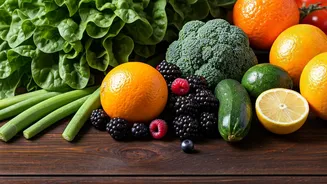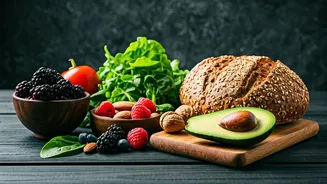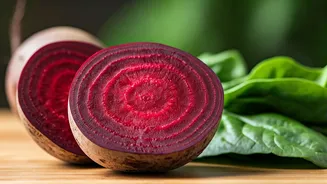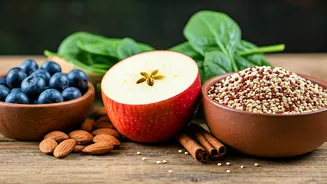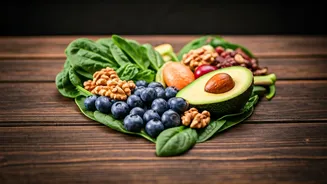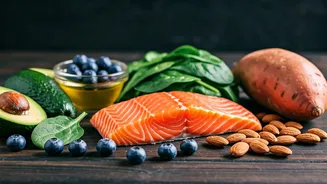Embracing Blood Sugar Control
Managing blood sugar levels is a crucial aspect of health, particularly for individuals with diabetes or those at risk. The foods we consume play a pivotal
role in this process. Eating foods that aid in blood sugar regulation not only supports metabolic health but can also ward off conditions like type 2 diabetes and promote general well-being. Diet choices can profoundly affect how the body processes glucose and maintains optimal energy levels. This article explores several foods that can be integrated into your diet to effectively manage blood sugar levels. By understanding and utilizing these options, you can actively take steps toward a healthier lifestyle. The focus is on offering actionable advice for incorporating these foods into your daily routine, encouraging a proactive approach to health management.
Introducing Fiber-Rich Foods
Fiber-rich foods are fundamental to blood sugar control. They help slow down the absorption of sugar, preventing spikes and crashes in blood glucose. Foods high in fiber take longer to digest, contributing to a feeling of fullness and aiding in weight management, which is closely linked to blood sugar control. Consider oats, which are easily incorporated into your breakfast routine. Oatmeal provides soluble fiber, which assists in reducing blood glucose levels and enhances insulin sensitivity. Additionally, lentils, a versatile legume, are excellent sources of both soluble and insoluble fiber. Lentils help regulate blood sugar and provide sustained energy release. Whole grains, another essential group, offer robust fiber and nutrient content. Choosing whole-grain bread, rice, and pasta over refined alternatives provides sustained blood sugar levels, helping in better metabolic management. Including these fiber-rich foods in your diet can be a straightforward step towards stabilizing your blood sugar.
Exploring the Power of Cinnamon
Cinnamon is celebrated not only for its flavor but also for its potential health advantages in regulating blood sugar. Studies have shown that cinnamon can enhance insulin sensitivity, making cells more receptive to glucose uptake. This process helps to lower blood sugar levels and prevents fluctuations. Incorporating cinnamon into your diet is simple: sprinkle it on your morning oatmeal, add it to coffee, or use it in baking. The active compounds in cinnamon seem to mimic insulin's effects, facilitating the movement of glucose from the bloodstream into the cells. This action minimizes the impact of post-meal blood sugar surges. Although cinnamon can be beneficial, it should be consumed as part of a balanced diet and lifestyle. The recommended daily amount varies, so it's best to consult with a healthcare provider for personalized advice.
Benefiting from Green Vegetables
Green vegetables are a cornerstone of a blood sugar-friendly diet. These vegetables are low in carbohydrates, high in fiber, and packed with vitamins and minerals, all of which contribute to blood sugar control. Spinach, kale, and other leafy greens are rich in antioxidants and nutrients, which support overall metabolic health. They contribute little to the overall carbohydrate load of a meal, thus minimizing their impact on blood sugar levels. Broccoli is another great choice, and provides high levels of fiber, as well as several beneficial compounds that improve insulin sensitivity. Consuming broccoli can help improve glucose control and reduce insulin resistance. Vegetables like these should form a core component of your daily meals, ideally filling at least half of your plate. They can be consumed raw, steamed, roasted, or as part of a stir-fry, adding variety to your diet while supporting stable blood sugar levels.
Adding Healthy Fats
Healthy fats play a key role in blood sugar management by slowing down the digestion process and preventing rapid glucose absorption. Foods rich in healthy fats, such as avocados, nuts, and seeds, should be incorporated into your meals. Avocados are rich in monounsaturated fats, along with fiber, which helps keep blood sugar levels steady. Adding a few slices to a meal provides both nutrients and satisfaction, reducing the likelihood of overeating. Nuts and seeds, like almonds, walnuts, and flaxseeds, provide healthy fats and fiber. These can be added to snacks or meals to provide sustained energy release and promote better blood sugar control. The strategic inclusion of healthy fats helps balance meals, reduces post-meal blood sugar spikes, and contributes to overall cardiovascular and metabolic health. It's important to consume these fats in moderation while ensuring a balance with protein and fiber for optimum health benefits.
Integrating Apple Cider Vinegar
Apple cider vinegar (ACV) has gained popularity for its potential benefits in blood sugar control, with research showing that ACV can improve insulin sensitivity and decrease post-meal blood sugar levels. Consuming ACV before meals, particularly those rich in carbohydrates, can help reduce the spike in blood glucose. The acids in ACV slow down the rate at which food leaves the stomach, preventing a rapid rise in blood sugar. It can be easily incorporated by diluting a tablespoon of ACV in water and drinking it before meals. However, it's essential to note that the impact can vary among individuals, and the taste may not be appealing to everyone. Start with a small amount and monitor its effects. Furthermore, ACV should not replace traditional treatments for diabetes. It's most effective when used as part of a comprehensive health strategy that incorporates a balanced diet, exercise, and medical oversight. Consult a healthcare professional to ensure that ACV is safe for your specific health needs.


